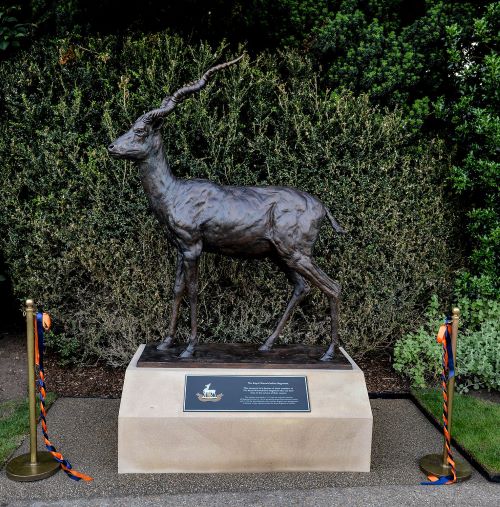
A bronze statue of Bobby the Blackbuck Antelope, the official mascot for the Royal Warwickshire Regiment and most recently The Royal Regiment of Fusiliers has been unveiled.
The unveiling was conducted by His Royal Highness The Duke of Kent, Colonel in Chief of the Regiment, and coincided with the 80th anniversary of the D Day landings, in which the Royal Warwickshire Regiment took part. 2024 also marks the 350th anniversary of the founding of the Regiment. The ceremony for invited guests took place at Warwick Castle on Thursday 6 June.
The regimental badge for the Royal Warwickshire Regiment has always been an antelope and according to stories of old it was first adapted from a Moorish banner captured during the Battle of Saragossa. After the Regiment was stationed in India, they began to adopt Blackbuck Antelopes as mascots and this tradition lasted for centuries. The Mascot was always called Bobby and sadly the last Bobby passed away in 2005 but the legacy of Bobby still remains a huge part of the Regiment’s life and traditions*.
The idea for the ‘Bobby’ memorial was that of former Are Colonel (Warwickshire), Colonel Richard Cariss back in 2020. Initial plans were drawn up but then due to the COVID 19 pandemic plans were then put on hold. Planning permission was finally granted in March last year with the ideal time for the unveiling to coincide with the 80th anniversary of the D Day landings as well as the Regiment’s 350th anniversary this year.
The iconic statue stands at over 2.5m tall on a stone plinth and is located in the Peacock Garden within the grounds of Warwick Castle. It has been created by renowned, wildlife sculptor, Knox Field, who is based in Oxfordshire. Through his commissions and personal projects Knox has an ever growing following that has seen him display his work around the country including at the Mall Gallery and La Galleria Pall Mall in London’s West End.
Colonel Richard Cariss MBE said “It is truly amazing to see ‘Bobby’ in his forever county home of Warwickshire and there is no better setting than within the magnificent grounds of Warwick Castle. It feels like the project has been a long time in the making, so it is great to finally see it come together and be unveiled on such a key date in history. A huge thank you to all involved in the project and for making it happen.”
Colonel James Denny, Regimental Secretary, The Royal Regiment of Fusiliers added “Bobby has been synonymous with the Regiment for more than 200 years so it’s extremely important that we honour the Regimental Mascot tradition with a fitting tribute that generations can enjoy and appreciate for many years to come. It is also a huge honour to have our Colonel in Chief, the Duke of Kent join us to unveil the statue.”
Knox Field, Sculptor commented “ Working to create Bobby, the Black Buck Antelope memorial sculpture for the Royal Warwickshire Regiment, has been the most rewarding project of my career to date. The challenge for me was to honour the stylised portrayal of the mascot on the regimental cap-badge whilst capturing the realism of a black buck in the wild. To see Bobby unveiled in the majestic surroundings of Warwick Castle on the 80th Anniversary of D-Day by the Duke of Kent, is quite simply amazing.”
The Royal Regiment of Fusiliers, known as ‘The Fusiliers,’ is an English infantry Regiment in the British Army, formed from four historic Fusilier Regiments in 1968. Since then, the Fusiliers have seen service across the world in Northern Ireland, Cyprus, the Balkans, the 1st and 2nd Gulf Wars and Afghanistan. The Regiment has two battalions – First Fusiliers in Tidworth and Fifth Fusiliers in Newcastle – and both adapt readily to challenging scenarios.
For further information about the regiment visit www.thefusiliers.org
*The Blackbuck Antelope as the Regimental Mascot is still on the establishment of the Regiment. However, the Indian Black Buck is a protected species and a herd animal. Therefore, it has been decision of the Regiment since 2005 for animal welfare reasons not to replace the Mascot with a live Indian Black Antelope.